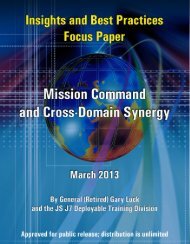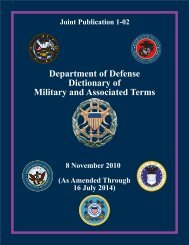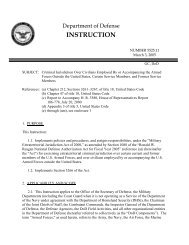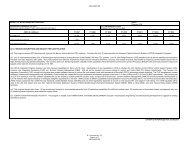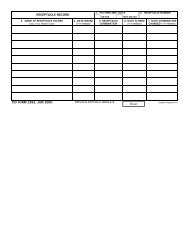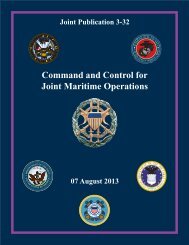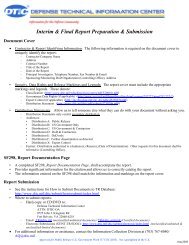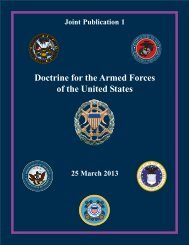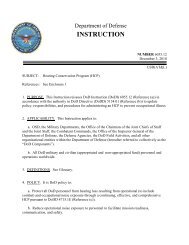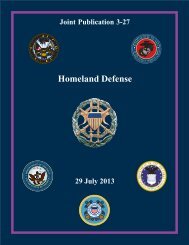JP 3-16, Multinational Operations - Defense Technical Information ...
JP 3-16, Multinational Operations - Defense Technical Information ...
JP 3-16, Multinational Operations - Defense Technical Information ...
Create successful ePaper yourself
Turn your PDF publications into a flip-book with our unique Google optimized e-Paper software.
Chapter III<br />
governed by Department of <strong>Defense</strong> Instruction (DODI) 8523.01, “Communications<br />
Security (COMSEC).” Detailed guidance outlining criteria for release of information<br />
security products, services, and information to foreign governments is provided in CJCSI<br />
6510.06, Communication Security Releases to Foreign Nations.<br />
g. Under CJCSI 6510.06, Communications Security Releases to Foreign Nations, the<br />
Chairman of the Joint Chiefs of Staff (CJCS) validates CCMD interoperability requirements<br />
to release COMSEC products or associated COMSEC information to any foreign<br />
government. These secure C2 interoperability requirements originate from the theater<br />
Service components.<br />
h. Release of COMSEC to foreign governments is permitted when there is a validated<br />
interoperability requirement. Specifically, the GCC and the MNFC should have or develop<br />
agreements on cryptographic, communications and/or automated data processing (ADP)<br />
security issues among all multinational components and understand where “capability gaps”<br />
exist, along with the implication of those gaps.<br />
14. Operational Environment<br />
a. Land <strong>Operations</strong>. In most multinational operations, land forces are an integral, and<br />
central, part of the military effort. The level and extent of land operations in a multinational<br />
environment is largely a function of the overall military objectives, any national caveats to<br />
employment, and the forces available within the MNF.<br />
(1) National doctrine and training will normally dictate employment options within<br />
the MNF. Nations with common TTP will also experience far greater interoperability.<br />
Effective use of SC activities may significantly reduce interoperability problems even for<br />
countries with widely disparate weapons systems.<br />
(2) The MNFC may assign the responsibility for land operations to an overall<br />
multinational force land component commander (MNFLCC) or a task force (TF) within the<br />
MNF command structure (for example: TF South, TF North). Such TFs may include<br />
elements from a single nation or multiple nations depending on the situation and the<br />
interoperability factors of the nations involved. In addition, the MNFC may also assign an<br />
area of operations (AO) to the MNFLCC or TF based upon concept of the operations. Figure<br />
III-4 contains a representative sample of MNFLCC responsibilities.<br />
(3) The MNFC will also establish supported and supporting relationships between<br />
the land component command or TF and other MNTF components (maritime, air, and<br />
special operations) based upon mission requirements to assist in prioritizing actions, assist in<br />
establishing the main effort, and to establish formal command/coordination channels<br />
between the components for a specific operation, mission, or phase.<br />
(4) A fundamental consideration for planning and executing land operations is<br />
sustainability. The following factors impact the sustainability of land operations:<br />
III-22 <strong>JP</strong> 3-<strong>16</strong>



